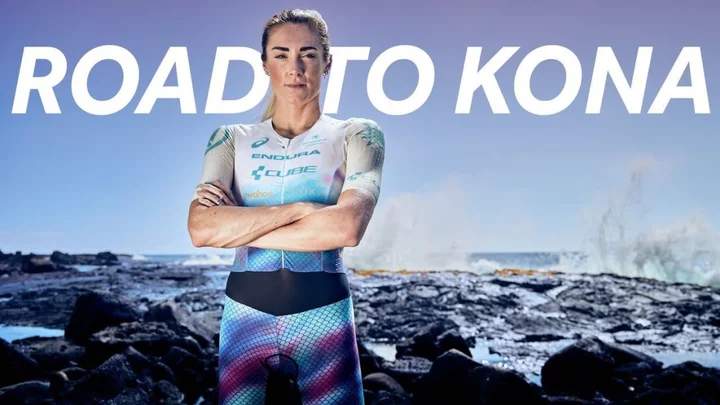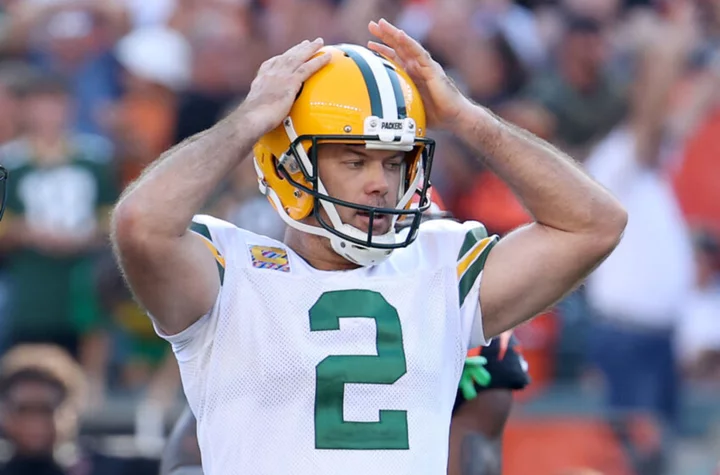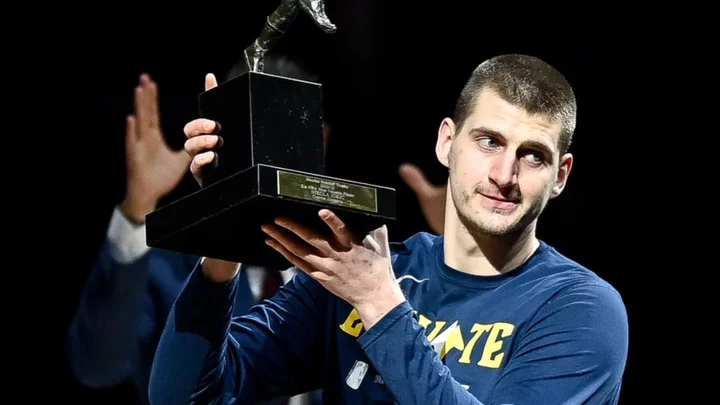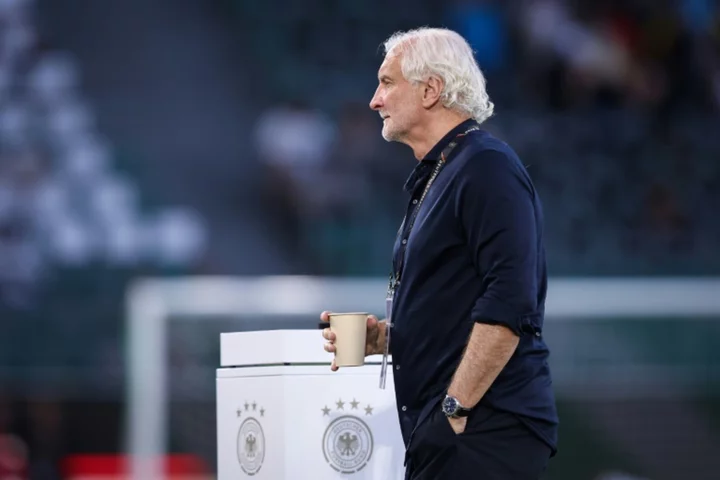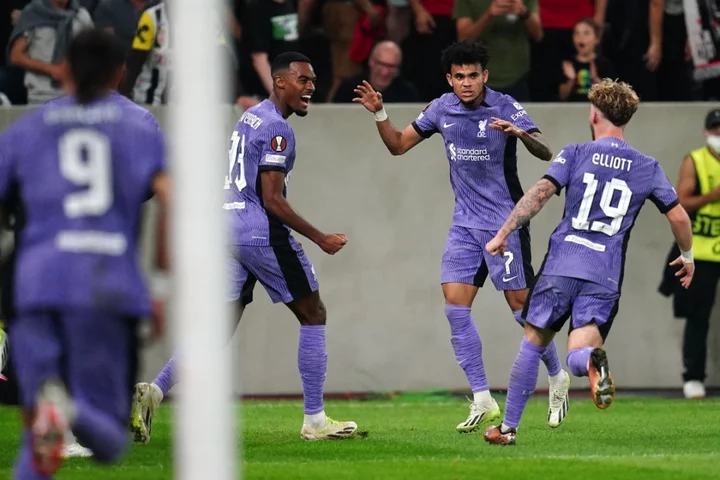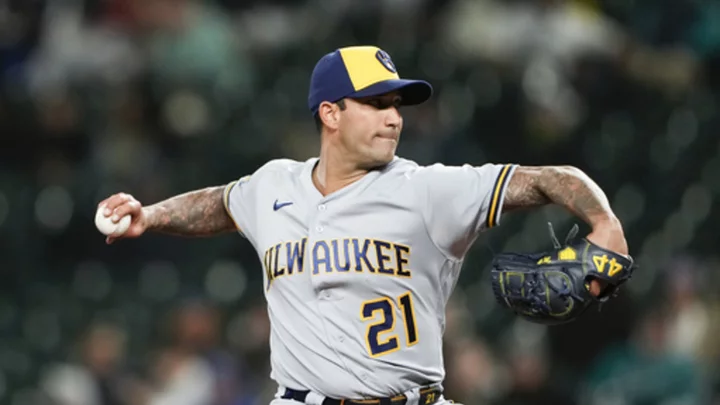Lucy Charles-Barclay reveals 'gruelling' training in 'pain cave' for Ironman Kona
Lucy Charles-Barclay has provided an insight into her “pretty gruelling” training routine ahead of competing at the Ironman World Championship set to take place today (October 14) in Kailua-Kona, Hawaii. The best female triathletes (both professional and age group) from around the world will test their strength and resilience on the 140.6-mile triathlon course - a 2.4-mile ocean swim in Kailua Bay, a 112-mile bicycle race along the Queen Ka’ahumanu Highway, ending with a 26.2-mile run to the Kaliua-Kona finish line. This year’s event marks the first-ever female-only race. After coming second in last year’s race, Charles-Barclay is hoping to do one better and get on the top step of the podium this time round. The 30-year-old British triathlete spoke to Indy100 last week on how she has prepared for the race, the highlights and challenges of her career so far. “I've been here for just over a week. Now kind of the main focus of my training the last week has just been acclimatised in because it's very hot and humid here,” she said, with the average air temperature at a sweltering 27° C. “The main thing is kind of getting the body used to that and then doing my final big sessions before I start to ease off next week. Nearly all of the hard work is done now.” Preparing for this kind of climate is “quite brutal” for Charles-Barclay who has been training for the hot Hawaii weather which includes doing “a lot” of indoor training with heaters, going in the sauna and having hot baths “as much as possible” to get used to the higher temperatures. “That seems to have paid off because it doesn't feel too bad. I mean, it is definitely hot here but I seem to be able to kind of put down some good performances in the training session so far. “So hopefully I'll be able to do that in the race as well,” Charles-Barclay added. Despite this intense heat training, races in warmer countries are the Brit’s preference. “I've raced all over the world but even though I'm from the UK, I definitely prefer hot races. I'm not someone who enjoys being cold so I normally pick races that are in hotter climates,” she explained. For Charles-Barclay, the average workout time to train for this kind of endurance in her three disciplines – swimming, cycling and running – is between three to six hours per day. To further prepare her body to endure the hardest moments of her races, the triathlete trains in a ‘pain cave’ at her husband’s parent’s house that was built by her father-in-law who used to be a professional boxer. Inside the aptly named ‘pain cave’ includes a boxing ring in the middle, a Woodway treadmill (self-powered treadmill, that burns 30% more calories), a Lever Movement anti-gravity running system, a ‘swim bench,’ and “all of the strength equipment.” Also, there is an Endless pool which is “like a treadmill for swimming and you can swim on the spot,” as well as indoor bikes from Oahu and the newly purchased Kickr Move “so it feels more like you're riding outside even [when] indoors.” “Basically, you could do a full triathlon indoors in there and we have done that regularly. But yeah, a lot of pain, sweat and tears goes on in there for sure,” she said. While breaking a sweat in the ‘pain cave’, there is a certain energy drink that helps “draw upon that caffeine” and “get through those really tough workouts that I'm doing regularly.” “It's definitely where Red Bull actually helps quite a lot because when you put three sessions a day, you definitely start to flag at some point.” Music also makes training “so much easier,” with the likes of Imagine Dragons, Eminem, NF as some of her favourite artists listen to, as well as “anything that just is a bit upbeat to get me going,” so of course, some Britney Spears tunes made it to her workout playlist. Out of her three disciplines, swimming is Charles-Barclay’s strength as she started as an elite-level swimmer trying to make the 2012 Olympic Games in the 1500 metres and she also competed in 5k and 10k open water swimming races before switching in 2013 to train as a triathlete. In 2014, she and her husband Reece Barclay completed their first Ironman and were “completely hooked.” “My now-husband and I decided to sign up for an Ironman and kind of have it as this challenge to try and achieve it which at the time, we didn't really know what we were getting ourselves into, but we actually really enjoyed the process.” After meeting as swimmers, Reece “naturally became the coach” that set out training when they both moved into competing in triathlons. Now, Charles-Barclay has Reece along with another coach to assist with her training. “Reece is the one that's there kind of every single day seeing what I'm doing adapting my training plan if we need to. He also was a pro triathlete himself and is now gone full-time assisting and helping me. “I probably definitely wouldn't do it without him. He makes it a lot easier.” The couple both qualified for the World Championships in 2015 as amateur athletes and in 2016, Charles-Barclay got her pro license. She then signed with Red Bull during this time in a partnership that has been “invaluable” to her career. “I guess they kind of took a leap of faith with me and their partnership has been huge to my performance over the years,” she explained. “Starting back in 2017, but kind of over the years, helping me overcome injuries that I've had, taking me out to Austria where they had the Performance Centre there and really diving into everything that it is to be an elite level athlete - whether that be psychology, physiology - just looking at every aspect as an athlete so that I can improve and be better." After almost a decade since her first Ironman, one of Charles-Barclay’s highlights was when she won the Half Ironman World Championships in 2021. “I won it in the best way that I could win it. I was the fastest across every discipline in the race and actually ended up winning by eight minutes,” she recalled. “So it's gonna be pretty hard to top that.” Remaining resilient in the face of injury is also a key quality for a sportswoman like Charles-Barclay to have. This year, she had a freak accident during Ironman 70.3 Kraichgau in Germany, where she broke her foot. “I didn't know that it broke. I just continued racing on it,” she said and an X-ray then showed she had completely broken through the metatarsal during the race. “We're still not really sure where it happened, which I think is one of the hardest things as an athlete, we kind of always look into everything can be sure why something happened so you can stop it [from] happening again.” While at the start of last year, a stress fracture in her femoral neck (a broken hip) impacted her 2022 season. “That was a long time out of racing and out of training. As an athlete, sitting still is our worst nightmare,” she admitted. Another difficulty is coming back from an injury and “trusting your body again” so as not to question, “Is it going to break on [me] again?” During those difficult times, Charles-Barclay received an influx of support from her social media followers (444,000 on Instagram, 90,000 on YouTube), who keep up with her performances as she documents her journey to inspire people to try out the sport for themselves. “One of the biggest things that I do is try and share my journey as much as possible online,” she said. “So via my YouTube channel or just on my social media trying to inspire other people to get involved in the sport as much as possible, particularly young women and girls to try and get them into the sport is kind of a really big thing that I try and push whilst I'm doing this.” The athlete added: “I get a lot of messages a lot of the time saying that. I've inspired them to maybe do their first-ever triathlon that might not be a full Ironman, but even just getting into a sprint distance triathlon. “I think it's an amazing sport to be part of. So the more people I can inspire to do that the better.” Lucy’s top tips on training for an Ironman Give yourself enough time “I think the minimum amount of time would be about six months to training for an Ironman just to complete it. So give yourself enough time to find a workout how long you need to train and how much time you need to dedicate to it.” Have a clear plan and get a coach “Whether you're working full time you might have a family it's quite hard to work around that so really have like a clear plan. And one of the best things you can do is definitely get a coach to help you along the way.” Take on the challenge with a friend "Try and convince some of your friends to do it with you because it can be quite a lonely sport. But if you've got other people to train with and make it more fun, I think that makes it a lot easier." Sign up to our free Indy100 weekly newsletter Have your say in our news democracy. Click the upvote icon at the top of the page to help raise this article through the indy100 rankings.
Lucy Charles-Barclay has provided an insight into her “pretty gruelling” training routine ahead of competing at the Ironman World Championship set to take place today (October 14) in Kailua-Kona, Hawaii.
The best female triathletes (both professional and age group) from around the world will test their strength and resilience on the 140.6-mile triathlon course - a 2.4-mile ocean swim in Kailua Bay, a 112-mile bicycle race along the Queen Ka’ahumanu Highway, ending with a 26.2-mile run to the Kaliua-Kona finish line.
This year’s event marks the first-ever female-only race.
After coming second in last year’s race, Charles-Barclay is hoping to do one better and get on the top step of the podium this time round.
The 30-year-old British triathlete spoke to Indy100 last week on how she has prepared for the race, the highlights and challenges of her career so far.
“I've been here for just over a week. Now kind of the main focus of my training the last week has just been acclimatised in because it's very hot and humid here,” she said, with the average air temperature at a sweltering 27° C.
“The main thing is kind of getting the body used to that and then doing my final big sessions before I start to ease off next week. Nearly all of the hard work is done now.”
Preparing for this kind of climate is “quite brutal” for Charles-Barclay who has been training for the hot Hawaii weather which includes doing “a lot” of indoor training with heaters, going in the sauna and having hot baths “as much as possible” to get used to the higher temperatures.
“That seems to have paid off because it doesn't feel too bad. I mean, it is definitely hot here but I seem to be able to kind of put down some good performances in the training session so far.
“So hopefully I'll be able to do that in the race as well,” Charles-Barclay added.
Despite this intense heat training, races in warmer countries are the Brit’s preference.
“I've raced all over the world but even though I'm from the UK, I definitely prefer hot races. I'm not someone who enjoys being cold so I normally pick races that are in hotter climates,” she explained.
For Charles-Barclay, the average workout time to train for this kind of endurance in her three disciplines – swimming, cycling and running – is between three to six hours per day.
To further prepare her body to endure the hardest moments of her races, the triathlete trains in a ‘pain cave’ at her husband’s parent’s house that was built by her father-in-law who used to be a professional boxer.
Inside the aptly named ‘pain cave’ includes a boxing ring in the middle, a Woodway treadmill (self-powered treadmill, that burns 30% more calories), a Lever Movement anti-gravity running system, a ‘swim bench,’ and “all of the strength equipment.”
Also, there is an Endless pool which is “like a treadmill for swimming and you can swim on the spot,” as well as indoor bikes from Oahu and the newly purchased Kickr Move “so it feels more like you're riding outside even [when] indoors.”
“Basically, you could do a full triathlon indoors in there and we have done that regularly. But yeah, a lot of pain, sweat and tears goes on in there for sure,” she said.
While breaking a sweat in the ‘pain cave’, there is a certain energy drink that helps “draw upon that caffeine” and “get through those really tough workouts that I'm doing regularly.”
“It's definitely where Red Bull actually helps quite a lot because when you put three sessions a day, you definitely start to flag at some point.”
Music also makes training “so much easier,” with the likes of Imagine Dragons, Eminem, NF as some of her favourite artists listen to, as well as “anything that just is a bit upbeat to get me going,” so of course, some Britney Spears tunes made it to her workout playlist.
Out of her three disciplines, swimming is Charles-Barclay’s strength as she started as an elite-level swimmer trying to make the 2012 Olympic Games in the 1500 metres and she also competed in 5k and 10k open water swimming races before switching in 2013 to train as a triathlete.
In 2014, she and her husband Reece Barclay completed their first Ironman and were “completely hooked.”
“My now-husband and I decided to sign up for an Ironman and kind of have it as this challenge to try and achieve it which at the time, we didn't really know what we were getting ourselves into, but we actually really enjoyed the process.”
After meeting as swimmers, Reece “naturally became the coach” that set out training when they both moved into competing in triathlons.
Now, Charles-Barclay has Reece along with another coach to assist with her training.
“Reece is the one that's there kind of every single day seeing what I'm doing adapting my training plan if we need to. He also was a pro triathlete himself and is now gone full-time assisting and helping me.
“I probably definitely wouldn't do it without him. He makes it a lot easier.”
The couple both qualified for the World Championships in 2015 as amateur athletes and in 2016, Charles-Barclay got her pro license.
She then signed with Red Bull during this time in a partnership that has been “invaluable” to her career.
“I guess they kind of took a leap of faith with me and their partnership has been huge to my performance over the years,” she explained.
“Starting back in 2017, but kind of over the years, helping me overcome injuries that I've had, taking me out to Austria where they had the Performance Centre there and really diving into everything that it is to be an elite level athlete - whether that be psychology, physiology - just looking at every aspect as an athlete so that I can improve and be better."
After almost a decade since her first Ironman, one of Charles-Barclay’s highlights was when she won the Half Ironman World Championships in 2021.
“I won it in the best way that I could win it. I was the fastest across every discipline in the race and actually ended up winning by eight minutes,” she recalled.
“So it's gonna be pretty hard to top that.”
Remaining resilient in the face of injury is also a key quality for a sportswoman like Charles-Barclay to have.
This year, she had a freak accident during Ironman 70.3 Kraichgau in Germany, where she broke her foot.
“I didn't know that it broke. I just continued racing on it,” she said and an X-ray then showed she had completely broken through the metatarsal during the race.
“We're still not really sure where it happened, which I think is one of the hardest things as an athlete, we kind of always look into everything can be sure why something happened so you can stop it [from] happening again.”
While at the start of last year, a stress fracture in her femoral neck (a broken hip) impacted her 2022 season.
“That was a long time out of racing and out of training. As an athlete, sitting still is our worst nightmare,” she admitted.
Another difficulty is coming back from an injury and “trusting your body again” so as not to question, “Is it going to break on [me] again?”
During those difficult times, Charles-Barclay received an influx of support from her social media followers (444,000 on Instagram, 90,000 on YouTube), who keep up with her performances as she documents her journey to inspire people to try out the sport for themselves.
“One of the biggest things that I do is try and share my journey as much as possible online,” she said.
“So via my YouTube channel or just on my social media trying to inspire other people to get involved in the sport as much as possible, particularly young women and girls to try and get them into the sport is kind of a really big thing that I try and push whilst I'm doing this.”
The athlete added: “I get a lot of messages a lot of the time saying that. I've inspired them to maybe do their first-ever triathlon that might not be a full Ironman, but even just getting into a sprint distance triathlon.
“I think it's an amazing sport to be part of. So the more people I can inspire to do that the better.”
Lucy’s top tips on training for an Ironman
Give yourself enough time
“I think the minimum amount of time would be about six months to training for an Ironman just to complete it. So give yourself enough time to find a workout how long you need to train and how much time you need to dedicate to it.”
Have a clear plan and get a coach
“Whether you're working full time you might have a family it's quite hard to work around that so really have like a clear plan. And one of the best things you can do is definitely get a coach to help you along the way.”
Take on the challenge with a friend
"Try and convince some of your friends to do it with you because it can be quite a lonely sport. But if you've got other people to train with and make it more fun, I think that makes it a lot easier."
Sign up to our free Indy100 weekly newsletter
Have your say in our news democracy. Click the upvote icon at the top of the page to help raise this article through the indy100 rankings.

